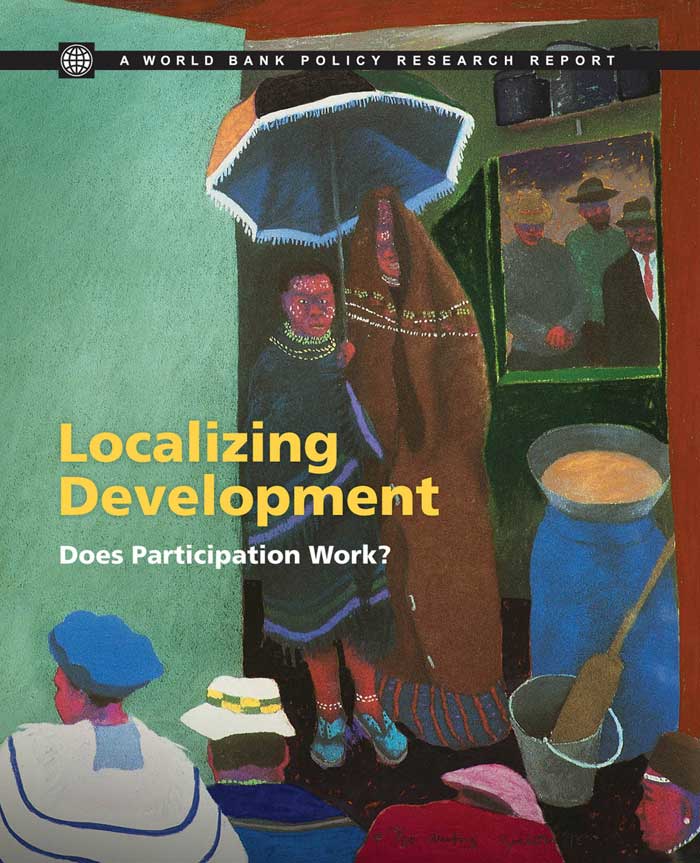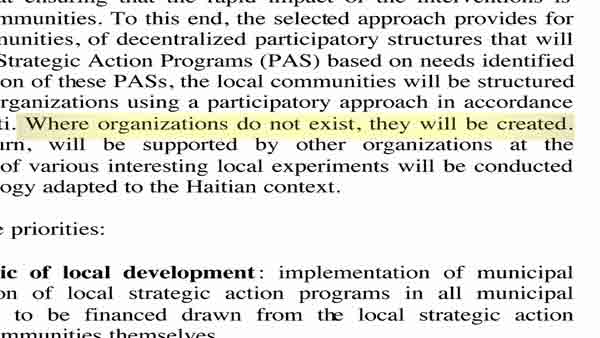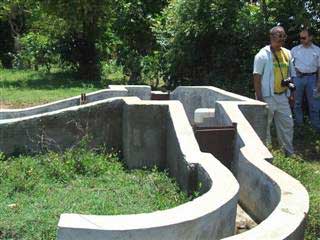World Bank "success" undermines Haitian democracy
part 1 of 3
Port-au-Prince, Haiti, Dec. 20 – A $61 million dollar, eight-year World Bank community development project implemented across half of Haiti has successfully repaired roads, built schools and distributed livestock. At the same time, however, Project for Participatory Community Development (PRODEP) – Projet de développement communautaire participatif – has also helped undermine an already weak state, damaged Haiti’s “social tissue,” carried out what could be called “social and political reengineering,” and raised questions of waste and corruption.
As part of an overall strategy encouraging communities to participate in the choice of development project in their regions, PRODEP awarded $17,500 grants to almost 1,500 community based organizations (CBOs) in 59 communes. But an eight-month investigation by Haiti Grassroots Watch (HGW) found that PRODEP did much more than pay for projects.
By encouraging groups to form in order to get cash grants, PRODEP contributed to Haiti’s growing status as an “NGO Republic.” The projects also damaged traditional solidarity systems and in some cases even strengthened the power of local elites.
Although HGW’s extensive fieldwork was concentrated in the Southeast, new reports by economists from World Bank – the institution that fundeed PRODEP – support the idea that the findings can be extrapolated.

In their articles and a new book – Localizing Development – Does Participation Work? – Ghazali Mansuri and Vijayendra Rao found that many “community driven development” or CDD projects tend to benefit the “wealthier, more educated” participants who are “often more politically connected” and who “tend to make decisions in community meetings.” These same “elites” can even build political support and run for office, the economists said.
Ironically, PRODEP’s national director touts the creation of new politicians.
At a press conference last July, Michael Lecorps, director of the Haitian government’s Office of Monetization of Aid and Development Projects BMPAD (Bureau de monétisation des programmes d’aide au développement) which oversees PRODEP, said: “There are a lot of people who became deputies [parliamentarians] because of PRODEP. They created platforms, they became leaders!”
While Lecorps may see the use of World Bank dollars to consolidate political fiefdoms as positive, others associated with PRODEP – even those sitting on the local community councils that oversee the projects – do not. Emile Theodore, a farmer outside the southeastern town of Bainet where HGW centered their research, deplored this construction of “political capital” as well as the sudden birth of dozens of “organizations” created solely to go after the funding.
“The fact that there was $17,500 for small projects meant that a lot of organizations got created so they could get those grants,” Theodore told HGW.
- What is the PRODEP project? What are its objectives and were they achieved?
- What do the projects look like in and around Bainet, in Haiti’s Southeast Department?
- How has the work been received by participants and staff at implementing agencies?
- What are the principal findings of the World Bank economists who warn of the dangers of “development fads”?
- What long-term harm might have been done to Haiti’s society and “social tissue”?
What is PRODEP?
In 2004, the World Bank launched PRODEP in Haiti. The work is mostly subcontracted to two international aid agencies: CECI (Centre d’Etude et de Cooperation International or Canadian Center for International Studies and Cooperation) and PADF (Pan-American Development Foundation). CECI and PADF set up technical bureaus throughout the country where staffers surveyed existing organizations and oversaw the creation of new ones.

Frame from a PRODEP video. See the video here.
See Haiti Grassroots Watch video here.
Based in part on a similar program in Brazil, a key intent was to calm the population.
“PRODEP began after all the political turbulence in the country,” explained Rincher Fleurent-Fils, coordinator of PRODEP’s technical office for the Southeast Department, in Jacmel. “The concern was to create social peace.”
This claim is substantiated by Bank documents written in conjunction with other principal supporters and funders of the interim government that was put into power following the illegal overthrow of President Jean-Bertrand Aristide in 2004.
The Interim Cooperation Framework (ICF) – released in July 2004 by the World Bank, the United Nations, European Union and Inter-American Development Bank – is a policy document meant to guide the “democratic transition” from the illegal removal of a head of state to a democratically elected government.
“The ICF is inspired by lessons learned in similar needs identification exercises in postconflict countries, such as Afghanistan, Iraq, East Timor and Liberia,” the authors note, even though the realities of those countries differ drastically with Haiti.
In fact, the ICF can be seen as a roadmap meant to insure the Haitian people accept the unconstitutional regime change and UN blue helmet mission. The map was laid out, the document claims, with participation from the “Haitian Government” and “civil society” – but was characterized by “the strong involvement of 26 bilateral, multilateral and United Nations agencies,” in other words, “the friends of Haiti.”
Among other actions, the ICF recommended the “establish[ment] of decentralized participatory structures” since local authorities are “weak.” The ICF then goes on to call for “rapid impact” and decentralized development “interventions” outside of government structures. Instead, the would be implemented by “the specialized local national organizations using a participatory approach in accordance with models already tested in Haiti” the report reads.
“Where organizations do not exist, they will be created,” the ICF says.

Page from the ICF.
According to the World Bank’s own reports, at least 232 new CBOs were “created as a result of the project” and then built them into regional councils and federations, almost like a set of private “Communal Assemblies,” the participatory assemblies called for in the Haitian Constitution which have yet to be established. A virtual parallel state. [For more on this “parallel state,” see Story 3]
The new and existing CBOs were given training and structured into regional councils called COPRODEPs. With assistance from CECI and PADF, the new councils oversaw the submission of projects from CBOs, voted on which ones PRODEP should fund and were mandated to supervise them. The projects fell into three categories: “productive” related to livestock, agriculture, fishing, etc.; “social” such as a community stores, schools or community centers; and “infrastructure” such as bridges, roads and water systems [see PRODEP photo, below]. According to the World Bank, the projects built or rehabilitated 785 kilometers of road, 444 water distribution points and 448 classrooms, and also contributed to building or stocking other community services like health clinics.

When all was said and done, the World Bank spent a total of $29 million on 1,519 projects.
(The groups actually got less than $17,500. According to a PRODEP/PADF official, 12 percent of the $17,500 went for administration: three percent ($525) for the COPRODEPs and nine percent ($1,575) went to the technical office overseeing the region.)
An additional $32 million – more than half the $61 million budget – went for training, administration, evaluation and other costs for BMPAD, CECI and PADF staff, according to the Bank. (Because HGW was never provided a budget or a copy of the evaluation completed in June 2012, despite being repeated promised that document, it was impossible to verify how money was actually spent.)
Building “social cohesion”
The PRODEP process was far from organic.
PRODEP staff and the central government had control over which organizations were given the right to submit projects, sit on the councils and decide on projects. According to Fleurent-Fils, an organization had to have been officially recognized by both the local mayor’s office and by the Ministry of Social Affairs to qualify.
“We looked at all the groups [in a region], to see what kind of organizations they were. Are they really community organizations?” PRODEPs Southeast coordinator Fleurent-Fils explained. “Once we were in touch with them, we helped them restructure themselves so they could enter into the PRODEP system.”
PRODEP officials claim that “over 70 percent” of projects were “successful,” first of all because the concrete goals were achieved, and secondly because they created “social cohesion.” This is a term used in PRODEP documents and by PRODEP staff, such as Lecorps and like Arcène Jerome, who heads up PRODEP in the five geographic departments where PADF ran the program.
“When all of the community organizations are federated into the COPRODEP, we have achieved our goal of reinforcing organizational capacity, reinforcing ‘networking,’ meaning links between them, to create what we call ‘social cohesion,’ because as we say, the objective is to construct ‘social capital,’” according to Jerome.
But Jerome’s claims run counter to the recent findings of the World Bank economists.
In their June 2012 paper “Can Participation Be Induced? Some Evidence from Developing Countries,” Mansuri and Rao said that “there is little evidence that induced participation builds long-lasting cohesion, even at the community level. Group formation tends to be both parochial and unequal… [P]eople are induced to participate and build networks. But they do so in order to benefit from the cash and other material payoffs provided by the project.”
“Overall, projects tend to have very limited impact in building social cohesion or in rebuilding the state. They tend to exclude the poor and are dominated by elites,” the authors noted. “Induced participation – particularly when it is packaged within a project – is almost set up for failure.”
Who is right? PRODEP or the World Bank authors?
Have “social capital” and “social cohesion” been constructed? Are 70 percent of projects successful? What is “success”?
Go to part 2 of World Bank "success" undermines Haitian democracy
Return to Introduction and video

